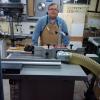
Originally Posted by
Dan Chouinard

There is no room in my 21' x 27' shop for multiple shapers. The original question was intended to determine if the PM shaper was a decent machine or a 650 lb hunk of crap.
No one has called it crap. This is comforting. And the difference between 3 and 5 horses was $200, not enough to even think about.
The inherent danger in shaper use is a real concern for me. The local cabinetmaker that has been at it since the early 70's lost an entire finger about 5 years ago to one of his shapers. That was a bit sobering (His only advice concerning a shaper purchase was 1 1/4" spindle and dont bother with 3 horse, get at least 5). I want to know everything there is to know about shaper safety practices before I think about plugging it in. Any feedback in this regard would be greatly appreciated.






 Reply With Quote
Reply With Quote

